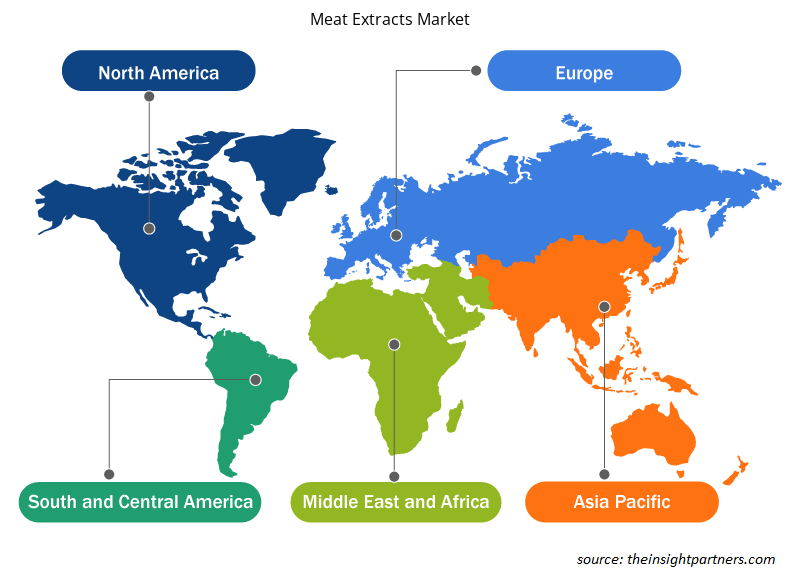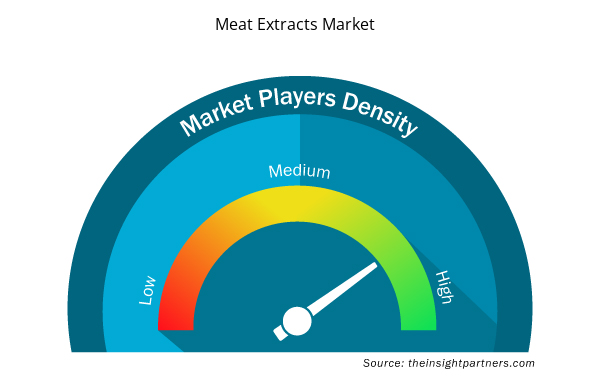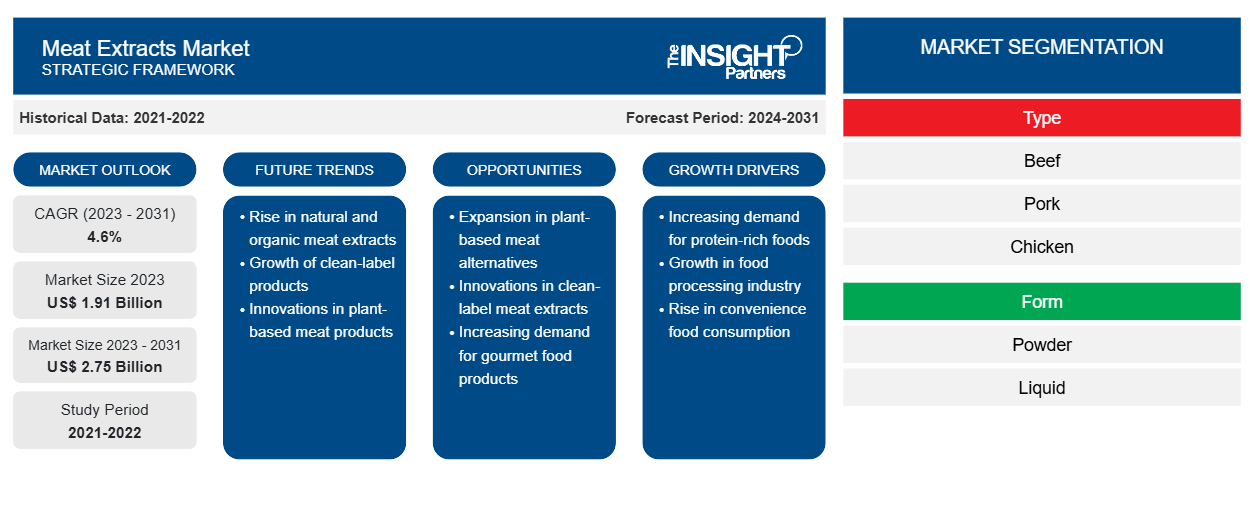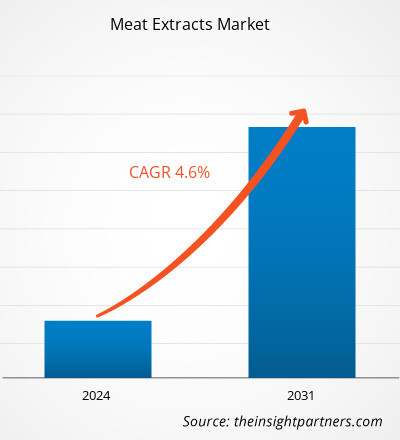肉类提取物市场规模预计将从 2023 年的 19.1 亿美元增至 2031 年的 27.5 亿美元。预计 2023-2031 年市场复合年增长率为 4.6%。随着许多消费者注重健康和保健,对蛋白质的需求大幅增加。由于生活节奏快、工作时间长,消费者无法满足日常饮食需求。因此,他们选择含有高蛋白质、维生素、矿物质和优质碳水化合物的功能性产品。
肉类提取物市场分析
肉提取物是一种辅助微生物人工培养的原料,主要用于细菌培养和发酵。它由优质肉类(通常是牛肉)经过受控酶分解制成。它是肌酸、肌酐、有机酸、水溶性氨基酸、核苷酸、多肽以及支持微生物在营养培养基上生长的矿物质和维生素等营养物质的极佳来源。肉提取物粉末为微生物提供碳、氮和能量,使它们能够最佳地生长和繁殖。肉提取物由特定的动物组织制成,可提高培养基的营养价值。它通常以 0.2% 至 1.0% 的浓度使用。
肉类提取物市场概况
肉提取物有液体和粉末两种形式。液体肉提取物是通过将小块肉放入水中煮沸,然后浓缩液体以达到所需的稠度而制成的。粉末状肉提取物可以通过干燥煮熟的肉块然后将其磨成细粉来获得。肉类零食、汤和酱料制造商使用肉提取物为产品增添特色风味。此外,它们还增加了产品的蛋白质含量,从而增加了它们对注重健康的消费者的吸引力。肉提取物被广泛用于制备培养基,用于培养不同的微生物。肉提取物富含蛋白质、氨基酸、蛋白胨、核苷酸等营养物质,可支持微生物以最佳速度生长和繁殖。此外,肉提取物还用于在实验室中开发培养肉。
定制此报告以满足您的需求
您可以免费定制任何报告,包括本报告的部分内容、国家级分析、Excel 数据包,以及为初创企业和大学提供优惠和折扣
- 获取此报告的关键市场趋势。这个免费样品将包括数据分析,从市场趋势到估计和预测。
肉类提取物市场驱动因素和机遇
肉类提取物作为增味剂的需求不断增长,市场前景看好
过去几年,随着全球人口增长、中等收入家庭数量增加以及对高蛋白、平价食品的需求不断增长,肉类产量和消费量大幅增加。禽肉是肉类行业增长的主要驱动力之一,因为它是一种价格实惠的蛋白质来源,而且被认为比牛肉和猪肉等其他肉类更健康。根据经济合作与发展组织和粮食及农业组织的统计,到 2030 年,全球肉类产量预计将达到 3.73 亿吨。此外,全球人均肉类消费量预计将达到 43.7 公斤零售重量(以零售重量表示)。
清洁标签和有机肉类提取物需求激增——机遇
消费者非常关注他们所消费的食品。他们更加关注产品标签和加工食品中使用的成分。有机产品因其公认的健康益处而越来越受欢迎。它们不含杀虫剂、化学肥料和转基因生物 (GMO),这增加了它们对愿意支付高价的消费者的吸引力。此外,消费者越来越喜欢不含合成香料、色素和其他食品添加剂的清洁标签肉类产品。此外,消费者注重整体和有意识的消费,并喜欢含有合乎道德的成分的产品。
肉类提取物市场报告细分分析
有助于得出肉类提取物市场分析的关键部分是类型、形式、应用和最终用户。
- 根据类型,肉类提取物市场分为牛肉、猪肉、鸡肉和其他。牛肉部分在 2023 年占据了较大的市场份额。
- 根据形式,市场分为粉末、液体和其他。粉末部分在 2023 年占据了最大的市场份额。
- 从应用方面来看,市场分为即食和即食餐、甜味和咸味小吃、汤和酱料等。其他部分在 2023 年占据了市场主导地位。
肉类提取物市场份额(按地区)分析
肉类提取物市场报告的地理范围主要分为五个地区:北美、亚太、欧洲、中东和非洲、南美/南美和中美。
北美主导着肉类提取物市场。由于肉类产品作为健康和富含蛋白质的食品的消费量不断增加,北美是肉类提取物市场的主要地区之一。美国是世界上最大的禽肉出口国和主要的鸡蛋生产国。随着饮食模式的改变,消费者对瘦肉的偏好日益增加,推动了该地区对鸡肉的需求。此外,由于愿意尝试新产品,美国和加拿大等国家的消费者已经开始选择肉类产品,包括培根,而不是煎饼等其他早餐选择。肉类提取物也用于培养基制备。例如,Hardy Diagnostics 是一家生产和销售细菌培养基的美国公司。他们制备牛肉提取物粉末并将其标准化以用于微生物培养基,通常用它来代替肉类浸液。多年来,牛肉提取物培养基一直被推荐作为水、牛奶和其他材料常规细菌学检查的标准。
肉类提取物市场区域洞察
Insight Partners 的分析师已详细解释了预测期内影响肉类提取物市场的区域趋势和因素。本节还讨论了北美、欧洲、亚太地区、中东和非洲以及南美和中美洲的肉类提取物市场细分和地理位置。

- 获取肉类提取物市场的区域特定数据
肉类提取物市场报告范围
| 报告属性 | 细节 |
|---|---|
| 2023 年的市场规模 | 19.1亿美元 |
| 2031 年市场规模 | 27.5亿美元 |
| 全球复合年增长率(2023 - 2031) | 4.6% |
| 史料 | 2021-2022 |
| 预测期 | 2024-2031 |
| 涵盖的领域 | 按类型
|
| 覆盖地区和国家 | 北美
|
| 市场领导者和主要公司简介 |
|
肉类提取物市场参与者密度:了解其对业务动态的影响
肉类提取物市场正在快速增长,这得益于终端用户需求的不断增长,而这些需求又源于消费者偏好的不断变化、技术进步以及对产品优势的认识不断提高等因素。随着需求的增加,企业正在扩大其产品范围,进行创新以满足消费者的需求,并利用新兴趋势,从而进一步推动市场增长。
市场参与者密度是指在特定市场或行业内运营的企业或公司的分布情况。它表明在给定市场空间中,相对于其规模或总市场价值,有多少竞争对手(市场参与者)存在。
在肉类提取物市场运营的主要公司有:
- 科林配料
- Carnad 天然口味
- 黛安娜集团
- PT Foodex Inti 配料
- 奇华顿公司
免责声明:上面列出的公司没有按照任何特定顺序排列。

- 获取肉类提取物市场顶级关键参与者概述
肉类提取物市场新闻及最新发展
肉类提取物市场通过收集一级和二级研究后的定性和定量数据进行评估,其中包括重要的公司出版物、协会数据和数据库。以下是言语和语言障碍市场的发展和策略列表:
2021 年 6 月,Essentia Protein Solutions 为其 ProFlavor 系列添加了一款新产品,名为 C3307 鸡肉味。这款最新的口味选择具有多种优势,包括蛋白质含量更高、碳水化合物含量更低以及不添加盐。它专门用于帮助创造低钠产品,同时仍提供浓郁正宗的鸡肉味道。(来源:Essentia Protein Solutions/公司网站)
肉类提取物市场报告覆盖范围和交付成果
“肉类提取物市场规模和预测(2021-2031)”报告对以下领域进行了详细的市场分析:
- 范围内涵盖的所有主要细分市场的全球、区域和国家层面的市场规模和预测
- 市场动态,如驱动因素、限制因素和关键机遇
- 未来的主要趋势
- 详细的 PEST/波特五力分析和 SWOT 分析
- 全球和区域市场分析涵盖关键市场趋势、主要参与者、法规和最新市场发展
- 行业格局和竞争分析,涵盖市场集中度、热点图分析、知名参与者和最新发展
- 详细的公司简介
- 历史分析(2 年)、基准年、预测(7 年)及复合年增长率
- PEST 和 SWOT 分析
- 市场规模价值/数量 - 全球、区域、国家
- 行业和竞争格局
- Excel 数据集


- Military Rubber Tracks Market
- Hair Extensions Market
- Educational Furniture Market
- Maritime Analytics Market
- Industrial Inkjet Printers Market
- Single Pair Ethernet Market
- Single-Use Negative Pressure Wound Therapy Devices Market
- Toothpaste Market
- Constipation Treatment Market
- Mobile Phone Insurance Market

Report Coverage
Revenue forecast, Company Analysis, Industry landscape, Growth factors, and Trends

Segment Covered
This text is related
to segments covered.

Regional Scope
North America, Europe, Asia Pacific, Middle East & Africa, South & Central America

Country Scope
This text is related
to country scope.
Trends and growth analysis reports related to Food and Beverages : READ MORE..
The Insight Partners performs research in 4 major stages: Data Collection & Secondary Research, Primary Research, Data Analysis and Data Triangulation & Final Review.
- Data Collection and Secondary Research:
As a market research and consulting firm operating from a decade, we have published and advised several client across the globe. First step for any study will start with an assessment of currently available data and insights from existing reports. Further, historical and current market information is collected from Investor Presentations, Annual Reports, SEC Filings, etc., and other information related to company’s performance and market positioning are gathered from Paid Databases (Factiva, Hoovers, and Reuters) and various other publications available in public domain.
Several associations trade associates, technical forums, institutes, societies and organization are accessed to gain technical as well as market related insights through their publications such as research papers, blogs and press releases related to the studies are referred to get cues about the market. Further, white papers, journals, magazines, and other news articles published in last 3 years are scrutinized and analyzed to understand the current market trends.
- Primary Research:
The primarily interview analysis comprise of data obtained from industry participants interview and answers to survey questions gathered by in-house primary team.
For primary research, interviews are conducted with industry experts/CEOs/Marketing Managers/VPs/Subject Matter Experts from both demand and supply side to get a 360-degree view of the market. The primary team conducts several interviews based on the complexity of the markets to understand the various market trends and dynamics which makes research more credible and precise.
A typical research interview fulfils the following functions:
- Provides first-hand information on the market size, market trends, growth trends, competitive landscape, and outlook
- Validates and strengthens in-house secondary research findings
- Develops the analysis team’s expertise and market understanding
Primary research involves email interactions and telephone interviews for each market, category, segment, and sub-segment across geographies. The participants who typically take part in such a process include, but are not limited to:
- Industry participants: VPs, business development managers, market intelligence managers and national sales managers
- Outside experts: Valuation experts, research analysts and key opinion leaders specializing in the electronics and semiconductor industry.
Below is the breakup of our primary respondents by company, designation, and region:

Once we receive the confirmation from primary research sources or primary respondents, we finalize the base year market estimation and forecast the data as per the macroeconomic and microeconomic factors assessed during data collection.
- Data Analysis:
Once data is validated through both secondary as well as primary respondents, we finalize the market estimations by hypothesis formulation and factor analysis at regional and country level.
- Macro-Economic Factor Analysis:
We analyse macroeconomic indicators such the gross domestic product (GDP), increase in the demand for goods and services across industries, technological advancement, regional economic growth, governmental policies, the influence of COVID-19, PEST analysis, and other aspects. This analysis aids in setting benchmarks for various nations/regions and approximating market splits. Additionally, the general trend of the aforementioned components aid in determining the market's development possibilities.
- Country Level Data:
Various factors that are especially aligned to the country are taken into account to determine the market size for a certain area and country, including the presence of vendors, such as headquarters and offices, the country's GDP, demand patterns, and industry growth. To comprehend the market dynamics for the nation, a number of growth variables, inhibitors, application areas, and current market trends are researched. The aforementioned elements aid in determining the country's overall market's growth potential.
- Company Profile:
The “Table of Contents” is formulated by listing and analyzing more than 25 - 30 companies operating in the market ecosystem across geographies. However, we profile only 10 companies as a standard practice in our syndicate reports. These 10 companies comprise leading, emerging, and regional players. Nonetheless, our analysis is not restricted to the 10 listed companies, we also analyze other companies present in the market to develop a holistic view and understand the prevailing trends. The “Company Profiles” section in the report covers key facts, business description, products & services, financial information, SWOT analysis, and key developments. The financial information presented is extracted from the annual reports and official documents of the publicly listed companies. Upon collecting the information for the sections of respective companies, we verify them via various primary sources and then compile the data in respective company profiles. The company level information helps us in deriving the base number as well as in forecasting the market size.
- Developing Base Number:
Aggregation of sales statistics (2020-2022) and macro-economic factor, and other secondary and primary research insights are utilized to arrive at base number and related market shares for 2022. The data gaps are identified in this step and relevant market data is analyzed, collected from paid primary interviews or databases. On finalizing the base year market size, forecasts are developed on the basis of macro-economic, industry and market growth factors and company level analysis.
- Data Triangulation and Final Review:
The market findings and base year market size calculations are validated from supply as well as demand side. Demand side validations are based on macro-economic factor analysis and benchmarks for respective regions and countries. In case of supply side validations, revenues of major companies are estimated (in case not available) based on industry benchmark, approximate number of employees, product portfolio, and primary interviews revenues are gathered. Further revenue from target product/service segment is assessed to avoid overshooting of market statistics. In case of heavy deviations between supply and demand side values, all thes steps are repeated to achieve synchronization.
We follow an iterative model, wherein we share our research findings with Subject Matter Experts (SME’s) and Key Opinion Leaders (KOLs) until consensus view of the market is not formulated – this model negates any drastic deviation in the opinions of experts. Only validated and universally acceptable research findings are quoted in our reports.
We have important check points that we use to validate our research findings – which we call – data triangulation, where we validate the information, we generate from secondary sources with primary interviews and then we re-validate with our internal data bases and Subject matter experts. This comprehensive model enables us to deliver high quality, reliable data in shortest possible time.


 获取此报告的免费样本
获取此报告的免费样本